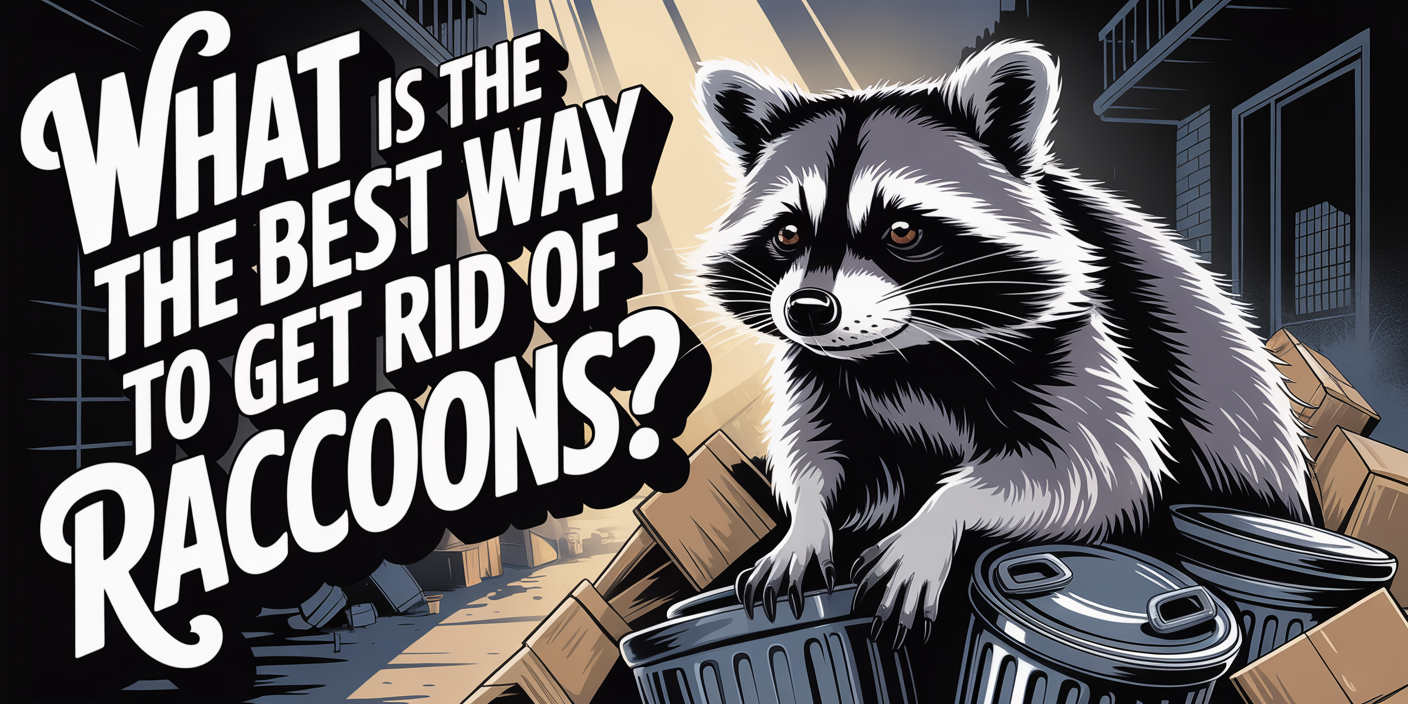“The best way to get rid of raccoons in Phoenix is to use humane exclusion techniques, like one-way doors, combined with sealing entry points to prevent them from returning. For long-term success and legal safety, it’s smartest to call a licensed wildlife removal expert like AAAC Wildlife Removal of Phoenix.”
Raccoons may look cute from a distance, but once they invade your attic, walls, or backyard, they quickly become a destructive (and noisy) nightmare. In Phoenix, where warm nights and easy food access make homes especially tempting, raccoon problems are more common than you’d think. This guide breaks down the smartest, safest ways to get rid of raccoons for good—without risking your property, your health, or your sanity.
What Smell Will Keep Raccoons Away?
Strong scents like ammonia, vinegar, and cayenne pepper are known to irritate raccoons’ sensitive noses and may temporarily keep them away from specific areas. These smells can work as short-term deterrents when applied near entry points, trash bins, or under decks.
However, Phoenix’s dry heat can cause these scents to evaporate quickly, making them far less effective without constant reapplication. While helpful as part of a broader plan, smell-based repellents alone won’t solve a full-blown raccoon problem.
Will Raccoons Leave on Their Own?
Raccoons might move on if they can’t find food, water, or shelter, especially in busy areas where they feel threatened. Sometimes, loud noises, motion-activated lights, or constant disruption can encourage them to vacate temporarily.
That said, if a raccoon has already nested—especially in attics or crawlspaces—they’re unlikely to leave on their own. In Phoenix, mother raccoons often raise litters in spring, and they won’t abandon their young without a serious reason to relocate.
What Are Humane Ways to Remove Raccoons?
One-Way Exclusion Devices
One of the most effective humane methods is installing a one-way exclusion door, which lets raccoons leave but prevents them from getting back in. This technique works best when all other entry points are sealed and there are no babies left behind.
Live Trapping (With Caution)
Live trapping is another option, but it must be handled carefully and in compliance with Arizona law. Improper trapping can lead to stress or injury for the animal and hefty fines for you, so it’s often safer to leave this to a licensed wildlife professional.
Is It Legal to Trap and Relocate Raccoons in Phoenix?
In Arizona, it’s illegal to trap and relocate raccoons without the proper permits from the Arizona Game and Fish Department. Relocating wildlife without authorization can harm the animal, disrupt ecosystems, and get you into legal trouble.
Even with a permit, relocation is rarely recommended because raccoons struggle to survive in unfamiliar areas. The safest and most compliant option is hiring a licensed wildlife control expert who understands state laws and humane handling procedures.
What Are the Signs of a Raccoon Infestation?
Visible and Audible Clues
Raccoons are mostly active at night, so common signs include loud thumping or scratching sounds coming from the attic or walls after dark. You might also notice tipped-over trash cans, droppings near entry points, paw prints along exterior walls, or roof damage around vents and chimneys.
In addition to the sounds, look for tipped-over trash cans, scattered food scraps, or droppings near potential entry points. Raccoon feces are typically blunt-ended and may be found on rooftops, patios, or in insulation. You may also notice muddy paw prints along exterior walls or window sills. Roof damage, especially around chimneys and attic vents, is another common sign they’ve forced their way in or are trying to.
Property Damage and Outdoor Clues
Raccoons are destructive by nature, often leaving behind broken shingles, torn screens, or holes near soffits and rooflines. Outdoors, look for scratch marks on fences, dug-up garden beds, or signs of digging under decks or sheds.
Outdoors, these animals also leave evidence of foraging and digging. Scratch marks on fences, damaged garden beds, and holes dug near decks or sheds are all signs of raccoons searching for food or denning spots. They often dig under structures to access cool, shaded crawlspaces, especially during the hotter months in places like Phoenix. Regular yard inspections can help you spot these issues before they escalate.
Nighttime Thumps and Scratches
If you’re hearing loud, deliberate thumping or scratchy movements in your attic or ceiling at night, it’s a classic raccoon red flag. These animals are nocturnal and surprisingly heavy-footed, so their movements can sound like someone walking around above you. You might notice the noises ramping up just after sunset and again around dawn—that’s when raccoons are most active.
In Phoenix homes, attics and wall cavities become prime targets thanks to their warmth in winter and shelter in summer. Don’t brush off those late-night sounds as just “the house settling.” If it’s rhythmic, loud, or sounds like something scurrying or dragging, it’s likely something living up there—and raccoons are among the top suspects.
Droppings and Sharp Odors
Raccoon droppings are unmistakable once you know what to look for. They’re typically dark, tubular, and blunt-ended, often full of visible seeds or undigested material. You’ll find them near attic access points, under insulation, or around roof corners. Unlike smaller critters like mice, raccoons tend to defecate in the same spots repeatedly, creating concentrated piles.
Those piles often come with a strong, eye-watering stench. An ammonia-like odor coming from vents, attic doors, or crawlspaces can mean urine has soaked into insulation or wood. That smell doesn’t fade quickly, and it’s a major health warning too—raccoon waste can carry dangerous parasites like Baylisascaris procyonis (raccoon roundworm).
Paw Prints and Grease Smudges
Raccoon tracks are weirdly human-like. They have five fingers, and their prints often look like small, spread-out handprints—especially if left in dust, mud, or near AC units. If you suspect something’s been creeping around your roof or window ledges, look for those telltale hand-shaped marks.
Along with prints, you might notice dark smudges around entry holes or along siding. These greasy marks are caused by raccoon fur brushing against surfaces over and over. They’re especially common around attic vents, roof gaps, and wall crevices—anywhere raccoons squeeze through regularly to come and go.
Roof, Duct, and Insulation Damage
Raccoons are not gentle guests. They rip off shingles, bend aluminum vent covers, and claw through soffit panels to get inside. If you’re seeing sudden roof damage or loose vents—especially near corners or attic eaves—there’s a good chance something forced its way in. Even a small gap can be an open invitation for a raccoon to expand and exploit.
Once inside, the damage gets worse. They’ll shred HVAC duct lining, rip up insulation to form nests, and trample everything in their path. This kind of destruction isn’t just messy—it disrupts airflow, reduces energy efficiency, and creates ideal breeding grounds for bacteria. Left unchecked, it can rack up thousands in repair costs.
Raided Trash and Disturbed Soil
If your trash is constantly being knocked over or your pet’s food disappears overnight, raccoons are likely behind it. These animals are scavengers with a great sense of smell and no fear of rummaging through bins, compost piles, or outdoor kitchens. Trash can lids left slightly ajar become easy targets.
They’re also strong diggers. If you spot freshly turned soil under a deck, near your shed, or along your foundation, don’t ignore it. Raccoons may be creating access tunnels or exploring crawlspaces for shelter. These digs can compromise structure integrity and give other pests a way in too.
How Do You Raccoon-Proof Your Property?
Eliminate Food Sources and Attractions
Start by securing all trash bins with tight-fitting lids and removing any pet food, bird seed, or fallen fruit that might attract raccoons. Keep outdoor areas clean and avoid leaving food or compost exposed overnight.
Store pet food indoors and clean barbecue grills after use, since raccoons are drawn to leftover grease and scraps. If you compost, use sealed containers and avoid adding meat or dairy products that produce strong odors.
Seal Entry Points and Limit Access
Inspect your home for gaps or holes near rooflines, soffits, chimneys, vents, and crawlspaces—these are prime raccoon entry spots. Use raccoon-proof materials like galvanized mesh, metal flashing, or vent caps to block access securely.
Also check under decks, sheds, and porches for signs of digging or nesting, then install barriers or lattice skirting buried a few inches underground. Regularly walk your property and recheck vulnerable areas, especially after storms or construction.
Modify Landscaping Around the Home
Trim overhanging branches, especially near the roof or attic vents, to reduce access routes to your home. Raccoons are agile climbers and often use trees, fences, or even utility lines to reach high places.
Remove dense shrubs or ivy that could offer cover or hiding spots close to your home’s foundation. In Phoenix, palm trees should be regularly pruned since old fronds can create ideal nesting ledges.
Install Motion-Activated Deterrents
Motion-activated lights, sprinklers, or noise devices can scare off raccoons before they get too comfortable. These tools work best when placed near known access points or food sources and combined with physical exclusion.
While these deterrents may lose effectiveness over time if used alone, they’re helpful as part of a layered strategy. Changing up their placement or type every few weeks helps maintain their impact.
Should I Call a Raccoon Removal Expert?
If raccoons are already inside your home or nesting near your property, calling a licensed wildlife removal expert is the safest move. Professionals can assess the situation, use humane methods, and ensure all animals—especially babies—are properly handled.
Experts in Phoenix are also familiar with local laws and environmental factors, which means they’ll know exactly how to remove raccoons legally and prevent them from coming back. They can also identify hidden entry points and damage you might miss on your own.
Call the Pros at AAAC Wildlife Removal of Phoenix
Don’t let raccoons turn your attic into a disaster zone. At AAAC Wildlife Removal of Phoenix, we specialize in humane raccoon removal, property inspections, and long-term prevention that keeps critters out for good. Our licensed team knows Arizona laws, understands local wildlife behavior, and delivers fast, reliable solutions with a personal touch.
Ready to take back your space? Call AAAC Wildlife Removal today for expert help and peace of mind—because wildlife belongs in the wild, not your home.
Conclusion
Getting rid of raccoons in Phoenix takes more than a quick fix—it requires the right combination of strategy, tools, and timing. While scents and DIY tricks might help in the short term, lasting results come from sealing entry points, removing attractants, and working with experts who understand local wildlife.
For homeowners serious about solving their raccoon problems the right way, calling in professional help isn’t just smart—it’s essential. Let AAAC Wildlife Removal of Phoenix guide you through a safe, legal, and effective solution that keeps your home raccoon-free for the long haul.




